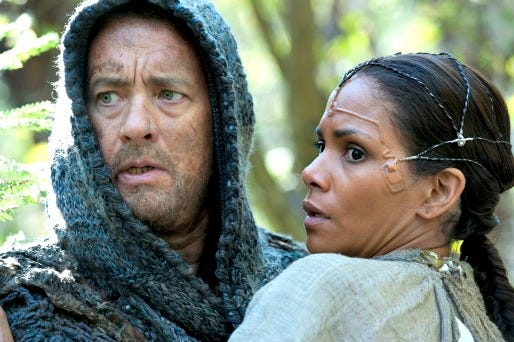Cloud Atlas

Having not read the novel by David Mitchell, my guess is that "Cloud Atlas" is one of those books that was considered untranslatable to the big screen. The Wachowski siblings, the creative team behind the "Matrix" films, and their writing/directing partner Tom Tykwer, have accomplished about as successful an adaptation as could be hoped.
It's a sprawling, ambitious, troubling, occasionally glorious and often vexing film. A hair under three hours long, it links dozens of characters across a multitude of time settings, with the same set of actors playing multiple parts. These stories do not unfold in temporal sequence but instead cut back and forth with no transition for the audience. The abruptness is intentional.
So, one moment you can be watching Tom Hanks playing Zachry, a suspicious but good-hearted hunter in a post-apocalyptic primitive society hundreds of years into the future, and in a blink, he has become Dr. Henry Goose, a nefarious physician/charlatan in the Pacific Islands circa 1849.
The theme here is that these actors are not simply inhabiting different roles but represent different incarnations of the same eternal soul replicated over and over again throughout the eons, facing much the same challenges in each reincarnation.
For instance, Hanks' character(s) struggle with summoning the courage to do the moral thing. For Dr. Goose, that battle was obviously lost some time ago. For Zachry, it's an ongoing struggle, with the forces of suspicion and hatred represented by Old Georgie, a devil in a top hat who whispers vile thoughts into his ear.
Zachry's time era is probably the most critical, acting as a framing device for the other stories. Sometimes we see the same person decades apart in their lives, but for the most part it is new incarnations each time around.
In Zachry's time, he is suspicious of Meronym (Halle Berry), a representative of a more technologically advanced alien culture or possibly the remnants of humanity that survived the "Big Fall" of mankind. Meronym and other people of her ilk seem to have electronic devices implanted under the surface of their skin, while Zachry and his people have extensive facial tattoos.
Meronym has ingratiated herself into the people of the valley's tiny community, where they struggle to survive against wretched tribes of cannibals who raid from time to time. Meronym says she's there to help and indeed heeds Zachry's plea to save the life of his niece, but it's clear she's there with an unspoken mission.
Other significant settings are the Pacific Islands in the mid-19th century, Cambridge of 1936, 1973 San Francisco, modern-day London, and Korea somewhere in the 23rd century.
Jim Broadbent plays Timothy Cavendish, an itinerant publisher who hits the big time when his thuggish author executes the dream of what every writer wants to do to a critic, becoming a celebrity in the process. But money troubles and a hateful big brother leave him incarcerated in a mental hospital, which builds up to a septuagenarian version of "The Great Escape."
Ben Whishaw is Robert Frobisher, a brilliant but poor musical genius who takes on a position as assistant to a once great but now forlorn composer. Jim Sturgess plays Adam Ewing, a young man making a highly profitable business trip for his slavemaster father-in-law who encounters the unexpected friendship of a runaway slave (David Gyasi).
In 1973, Halle Berry plays Luisa Rey, a crusading young journalist who uncovers a nefarious plot at a Three Mile Island-ish nuclear facility, and finds her life in peril.
Perhaps the most evocative setting is Neo Seoul of the future, a nightmarish landscape that seems to combine the worst societal elements of "Blade Runner" and "The Matrix." Here, Doona Bae plays Sonmi-451, a "fabricant" — aka synthetically created human slave — who serves as a waitress in a trendy restaurant. One day, she's liberated by a leader of the rebellion against this totalitarian society and finds herself becoming the image and voice of a movement (and later, in Zachry's time, something much more).
"Our lives are not our own," Somni intones, underscoring the film's message. "From womb to tomb, we are bound to others, past and present. And by each crime and each kindness, we build our future."
I will say that time does not drag while watching "Cloud Atlas." I looked at my watch exactly once and was astonished to see that 2½ hours had already gone by.
But the various actors each playing three, four, five or more roles ended up being distracting, especially as I attempted each time to puzzle out who was who under the heavy layers of prosthetic makeup. I found that the mental energy I expended in this exercise left me unable at time to get emotionally engaged in the characters' plight.
I also admit to being uncomfortable with some of the transformations. At various times, Caucasian actors are made up to look Asian, Asians as Caucasians, and African-Americans as whites or Asians or Latinos, and none of it very convincing. I did note that at no time was a non-African-American actor made up to look black. Consciously avoiding that risk of an unpalatable accusation of blackface only serves to make the other cross-racial portrayals seem even more squeamish.
"Cloud Atlas" is a bedazzling cinematic experience, though one that will no doubt leave some audience members confused and frustrated. For me, there was enough enchantment to overcome the head-scratching.
4 Yaps



